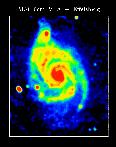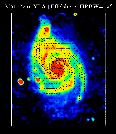 gzip'd postscript
[250K]
gzip'd postscript
[250K]
 gzip'd postscript
[273K]
gzip'd postscript
[273K]
Figures:
 gzip'd postscript
[250K]
gzip'd postscript
[250K]
 gzip'd postscript
[273K]
gzip'd postscript
[273K]
From p181bck@mpifr-bonn.mpg.de Wed Dec 2 09:07:45 1998
Date: Wed, 2 Dec 1998 16:59:13 +0100
From: p181bck@mpifr-bonn.mpg.de (Rainer Beck)
To: ccarilli@NRAO.EDU
Subject: VLA upgrade
Content-Length: 3399
X-Lines: 76
Status: RO
Proposal of a VLA upgrade for polarization observations
-------------------------------------------------------
The VLA is an excellent instrument to observe extended polarization
of galaxies. In recent years we learnt a lot about the structure
and strength of interstellar magnetic fields. HGowever, our knowledge
is still very limited, and some of the major questions are still
unsolved:
1. Are interstellar fields primordial or generated by dynamos?
This can be decided by determination of patterns in the Faraday
rotation measures. To avoid beam depolarization, high angular
resolution is required.
2. If dynamos work, what drives them?
This needs high-resolution observations of fields near possible
sources of ISM turbulence.
3. How strong and how regular are magnetic fields in young galaxies?
How fast can the magnetic field develop?
This needs polarization observations of distant galaxies with
high resolution.
4. Is the pitch angle of the field in spiral galaxies determined by the
dynamo or by the density wave?
This needs accurate observations of polarization angles, i.e. high
signal-to-noise ratios, especially in smooth, low-brightness interarm
regions.
5. What is the diffusivity of interstellar fields?
Under which conditions is the field frozen into a gas flow?
This needs high-resolution comparison between gas flows as determined
from CO or HI data and the field structure, not only in spiral
galaxies, but also in barred and irregular ones.
6. Which component of the ISM gas is mainly responsible for anchoring
the magnetic fields?
This needs high-resolution comparisons with CO, HI, HII, etc.
7. Are interstellar fields deformed by star-formation processes, and
do they influence star formation?
This needs high-resolution observations.
All these questions need high-sensitivity and (mostly) high-resolution
polarization observations. While the resolution of the VLA is fully
sufficient even in its present configurations, SENSITIVITY is what
limits us at the moment. We detected significant polarized intensities
in D-array at 3cm and 6cm in all spiral galaxies and some irregulars.
In C-array, only bright galaxies like M51 are visible in polarized
emission. With higher resolution, intensities per beam become too low.
To achieve the aims as listed above, a significant increase in
sensitivity is ESSENTIAL, such that we gain MORE THAN A FACTOR OF 10
in observation time.
We don't need a continuous frequency coverage because we concentrate
on frequencies where the missing spacings can be filled by our
Effelsberg single-dish data, i.e. X- and C-band. L-band polarization
data are generally corrupted by Faraday depolarization. To obtain
accurate rotation measures, a large frequency separation is required
in the Faraday-thin regime. RM(3/6cm) is often insufficient, thus
another, longer wavelength (e.g. 11cm, also available at Effelsberg)
is of high importance for our work.
More telescopes near the center of the array would help to see the
weak, extended emission. Filling the missing spacings with Effelsberg
data only helps for large galaxies. The Effelsberg beam e.g. at 6cm is
2.45' and can fill all missing spacings only for the D-configuration.
We are looking forward to the future glory of the VLA !
Rainer Beck, on behalf of the MPIfR continuum group
VLA Expansion Project Science
VLA Expansion Project Home Page